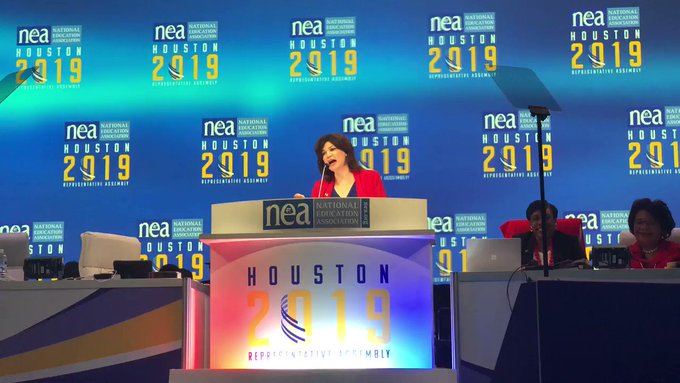NEA President: "Something Big Is About to Happen" - NEA Today
NEA President: “Something Big Is About to Happen”
Eskelsen García delivered
her speech on July 4, usually a day to celebrate freedom and independence. Now, she said, everyone must stand up for something that is endangered.
“I’ve taken it for granted that in an open, democratic society, the moral arc of the universe would always bend towards justice,” she said. “That our country would keep finding ways to be more inclusive of folks who had been excluded; that we’d be looking for ways to give opportunities to folks who had so little; that we’d see more ways to appreciate our diversity of cultures and languages and races and our LGBT communities.”
Now more than ever, the nation needs its educators to take up the call. “The moral arc of the universe needs us now to put our backs into education justice,” Eskelsen García told delegates.
It’s already happening. In early 2018, West Virginia educators staged a historic walk-out sparking the national
#RedforEd movement that quickly spread to states whose schools had buckled under a decade of extreme budget cuts.
Suddenly, politicians everywhere were listening.
“Even without a march, surprising doors were opened. Politicians who usually said, ‘Talk to the hand,’ reached out to our leaders and said, ‘Let’s talk. We would so rather you not go all West Virginia on us,” Eskelsen García said.
Momentum carried over
into the fall with the midterm elections. Educators delivered in spectacular fashion, helping sweep pro-education candidates—many of them former or current educators—into office at every level of government. Jahana Hayes, the 2016 National Teacher of the Year, was elected to the U.S. House of Representatives.
Educators should never apologize, never shy away from being “political,” Eskelsen García said.
“Political action isn’t subversive. It’s the essence of democracy. Showing up informed and engaged, prepared to make a difference is exactly what democracy looks like.”
And NEA is prepared to be powerfully engaged in the 2020 election.
“I hope I’m not being too subtle. I want to be clear,” Eskelsen García said. “The United States of America must have a new president. …Donald Trump is pushing our beautiful, imperfect nation towards authoritarianism and despotism. In the history of history, wherever authoritarian, anti-democratic despots took over, they had a common strategy. It’s about who you oppress, who you scapegoat, and the institutions you corrupt.”


















